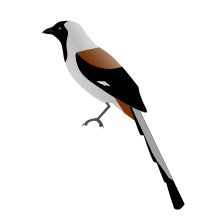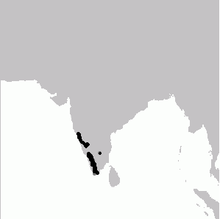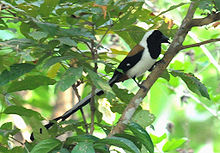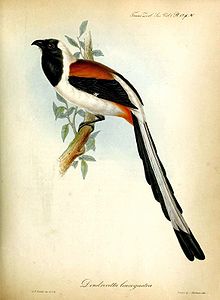- White-bellied Treepie
-
White-bellied Treepie 
Conservation status Scientific classification Kingdom: Animalia Phylum: Chordata Class: Aves Order: Passeriformes Family: Corvidae Genus: Dendrocitta Species: D. leucogastra Binomial name Dendrocitta leucogastra
Gould, 1833[2]
The White-bellied Treepie (Dendrocitta leucogastra) is a bird of the crow family endemic to the forests of southern India. They overlap in distribution in some areas with the Rufous Treepie but are easily to tell apart both from appearance and call.
Contents
Description
The white of the head and body makes it easy to distinguish from the sympatric Rufous Treepie. This tends to be found in more dense forest and is less associated with human habitation than the Rufous Treepie.[3]
Calls (Recorded in Wayanad)
When calling, the bird bows and droops its wings. Several birds may arrive at one tree and call repeatedly during the pre-monsoon breeding season (mainly April–May but some nests from February). The nest is a platform of twigs on a medium sized tree. Three eggs are laid, ashy grey with green and grey blotches.[4][5]
It is associated with mixed-species foraging flocks and is often found along with Greater Racket-tailed Drongos.[3]
Distribution
It is found in the forests of the Western Ghats mainly south of Goa.[6] A record from Erimalai near Dharmapuri[7] and reports from the Surat Dangs and the southeastern Ghats of Andhra Pradesh stand outside its main distribution range. A record from central India (Chikalda, Gawilgarh[5]) has been questioned.[3]
Gallery
-
From Manamboli, Indira Gandhi Wildlife Sanctuary and National Park, Anamalais, Valparai, Tamil Nadu, India
-
From Manamboli, Indira Gandhi Wildlife Sanctuary and National Park, Anamalais, Valparai, Tamil Nadu, India
References
- ^ BirdLife International (2009). Dendrocitta leucogastra. In: IUCN 2008. IUCN Red List of Threatened Species. Downloaded on 25 November 2009.
- ^ Gould, J. (1835). "X. On a new Genus in the Family of Corvidae". Transactions of the Zoological Society of London 1: 87–90. doi:10.1111/j.1096-3642.1835.tb00606.x. http://www.archive.org/stream/transactionsofzo01zool#page/n123/mode/1up.
- ^ a b c Rasmussen, PC & JC Anderton (2005). Birds of South Asia: The Ripley Guide. Volume 2. Smithsonian Institution & Lynx Edicions. p. 596.
- ^ Hume, A O (1889). The Nests and Eggs of Indian Birds. Volume 1. R H Porter, London. p. 22. http://www.archive.org/stream/nestseggsofindia01humerich#page/22/mode/2up/search/leucogastra.
- ^ a b Baker, ECS (1922). The Fauna of British India, Including Ceylon and Burma. Volume 1. Taylor and Francis, London. pp. 51–52. http://www.archive.org/stream/faunaofbritishin01bake#page/52/mode/2up.
- ^ Daniels, R J Ranjit, NV Joshi & Madhav Gadgil (1992). "On the relationship between bird and woody plant species diversity in the Uttara Kannada district of South India". Proc. Natl. Acad. Sci. 89 (12): 5311–5315. doi:10.1073/pnas.89.12.5311. PMC 49281. PMID 11607298. http://www.pnas.org/content/89/12/5311.full.pdf?ck=nck.
- ^ Daniels, R.J.R. & MV Ravikumar (1997). "Birds of Erimalai". Newsletter for Birdwatchers 37 (5): 80–82.
Extant species of family Corvidae Kingdom: Animalia · Phylum: Chordata · Class: Aves · Subclass: Neornithes · Superorder: Neognathae · Order: PasseriformesFamily Corvidae Choughs Treepies Andaman Treepie (D. bayleyi) · Bornean Treepie (D. cinerascens) · Grey Treepie (D. formosae) · Black-faced Treepie (D. frontalis) · White-bellied Treepie (D. leucogastra) · Sunda Treepie (D. occipitalis) · Rufous Treepie (D. vagabunda)PlatysmurusTemnurusOriental
magpiesOld World jays PtilostomusStresemann's
BushcrowZavattariornis
Categories:- IUCN Red List least concern species
- Birds of India
- Dendrocitta
Wikimedia Foundation. 2010.
Look at other dictionaries:
white-bellied treepie — baltapilvė dendrocita statusas T sritis zoologija | vardynas atitikmenys: lot. Dendrocitta leucogastra angl. white bellied treepie vok. Weißbauch Baumelster, f rus. белобрюхая древесная сорока, f pranc. témia à ventre blanc, f ryšiai: platesnis… … Paukščių pavadinimų žodynas
White-bellied — may refer to:In ornithology:* White bellied Antbird, passerine bird which breeds in the tropical New World from Panama to northern Brazil and in Trinidad * White bellied Blue Flycatcher, small passerine bird in the flycatcher family Muscicapidae… … Wikipedia
White-necked Crow — Conservation status Vulnerable (IUCN 3.1) Scientific classification Kingdom … Wikipedia
White-billed Crow — Conservation status Least Concern ( … Wikipedia
White-naped Jay — In Natal, Rio Grande do Norte, Brazil Conservation status … Wikipedia
White-tailed Jay — Conservation status Least Concern (IUCN 3.1) Scientific classification Kingd … Wikipedia
White-throated Jay — Conservation status Vulnerable (IUCN 3.1) Scientific classification Kingdo … Wikipedia
White-collared Jay — Conservation status Least Concern (IUCN 3.1) Scientific classification Kin … Wikipedia
White-necked Raven — For the bird formerly known as the American White necked Raven, see Chihuahuan Raven. White necked Raven Conservation status … Wikipedia
Treepie — Taxobox name = Treepies image caption = Grey Treepie regnum = Animalia phylum = Chordata classis = Aves ordo = Passeriformes familia = Corvidae subdivision ranks = Genera subdivision = * Dendrocitta * Crypsirina * Temnurus * Platysmurus The… … Wikipedia
-





